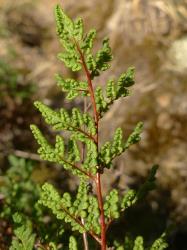Terrestrial or rupestral ferns. Rhizomes short- to long-creeping, scaly. Rhizome scales non-clathrate, narrowly ovate, attached at base, concolorous or bicolorous, light to dark brown. Fronds monomorphic (NZ) or rarely dimorphic (not NZ). Stipes and rachises red-brown. Laminae 2–3-pinnate (NZ) or 1-pinnate and 4–5-pinnate (not NZ), herbaceous or coriaceous, glabrous or scaly and/or hairy, sometimes farinose abaxially (not NZ). Pinnae and ultimate lamina segments not articulated to rachis and costae. Veins free (NZ) or rarely reticulate (not NZ). Sori terminating veins at lamina margin, or extending almost continuously along the margins; paraphyses present; sori ± protected by the unmodified inrolled lamina margin. Spores trilete, lacking chlorophyll; perispores verrucate, tuberculate or echinate, without an equatorial flange.
A genus of c. 100 species, included in the subfamily Cheilanthoideae along with Myriopteris and Pellaea (PPG 1 2016).
Cheilanthes, as currently construed (Eiserhardt et al. 2011; Zhang & Yatskievych 2013; PPG 1 2016), is not monophyletic, and is in need of a comprehensive phylogenetic study to determine generic boundaries within the group. One New Zealand species was previously included in the genus Notholaena (e.g. Cheeseman 1925, as Nothochlaena), which was first described from Australia by Brown (1810). However, the typification of Notholaena has been very controversial, and the genus is now considered to be typified by a New World species, and confined to the Americas (Yatskievych & Smith 2003; Rothfels et al. 2008; PPG 1 2016).
The Australian species of Cheilanthes, including both species indigenous to New Zealand, have been extensively reviewed by Quirk et al. (1983) and Chambers & Farrant (1991, 1998), and those in southern Africa by Anthony (1984). Allan (1961) followed earlier New Zealand Flora writers in accepting three species, but one of them, C. tenuifolia, is now thought to occur in coastal regions of Queensland and Northern Territory, extending to Nepal, India, Sri Lanka, South-East Asia and the Pacific islands (Chambers & Farrant 1991). Plants attributed to this species in New Zealand have been re-identified as large forms of C. sieberi. In addition, C. viridis (as Pellaea viridis) was recognised as a casual species in New Zealand by Webb et al. (1995).
In New Zealand, species of Cheilanthes can be recognised by their small to medium-sized 2–3-pinnate fronds, sori extending around the lamina edges protected by the inrolled pinna margins, and scabrate to verrucate spores (Large & Braggins 1991). They occur most frequently in dry, rocky habitats.
Cheilanthes is distributed in Europe, Africa, Asia, Australasia, Oceania and South America, with centres of diversity in South Africa, Australia and South America; 17 species in China (Zhang & Yatskievych 2013), 24 in South Africa (Roux 2009), 15 in Australia (Chambers & Farrant 1998), and five in the south-west Pacific (Nakamura 2008). Three species in New Zealand; two indigenous and one naturalised, none endemic.
| Category | Number |
|---|---|
| Indigenous (Non-endemic) | 2 |
| Exotic: Casual | 1 |
| Total | 3 |
Base chromosome numbers of x = 26, 27, 28, 29 and 30 have been recorded in Cheilanthes. There is also an extensive polyploid series from diploid to hexaploid, and several species are known to be apomictic (Tindale & Roy 2002).




